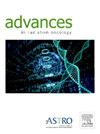超低分割影像引导下部分乳房照射治疗早期乳腺癌的二期临床研究
IF 2.7
Q3 ONCOLOGY
引用次数: 0
摘要
目的加速乳房部分照射在低风险乳腺癌保乳治疗中得到广泛接受,但其在肿瘤整形手术后的作用仍存在争议。方法和材料我们进行了一项前瞻性2期试验,患者年龄在50岁及以上,雌激素受体阳性,在成功的乳房肿瘤切除术和选择性的肿瘤整形重建后,0至1期乳腺癌测量≤3cm。患者在Varian Edge放射外科系统上接受5次30 Gy的处方剂量治疗,主要终点是可行性和安全性。使用乳腺癌治疗结果量表验证仪器评估患者报告的美容。结果2018 - 2022年共纳入50例患者,共52例肿瘤,中位年龄76岁,其中侵袭性乳腺癌79%,肿瘤整形重建48%。中位随访时间为47个月,89%的患者报告长期美容效果极佳,11%的患者报告美容效果良好。所有患者均得到局部控制,但有2例同侧乳房事件,包括乳腺内淋巴结衰竭和放射场外的第二次原发性三阴性乳腺癌,均通过进一步的局部和全身治疗成功挽救。结论在精心挑选的低风险早期乳腺癌患者中,采用部分乳房放射治疗方案的患者获得了良好的美容和肿瘤预后。肿瘤成形性重建并不是乳房部分照射的禁忌症。本文章由计算机程序翻译,如有差异,请以英文原文为准。
Phase 2 Trial of Ultrahypofractionated Image-guided Partial Breast Irradiation Following Lumpectomy with Optional Oncoplastic Reconstruction for Early-stage Breast Cancer
Purpose
As accelerated partial breast irradiation is gaining widespread acceptance for low-risk breast cancers treated with breast conservation, its role following oncoplastic surgery remains controversial.
Methods and Materials
We performed a prospective phase 2 trial of women aged 50 and older who were estrogen receptor positive with stage 0 to 1 breast cancer measuring ≤3 cm following successful lumpectomy with optional oncoplastic reconstruction. Patients were treated on the Varian Edge radiosurgery system to a prescribed dose of 30 Gy in 5 fractions, and the primary endpoints were feasibility and safety. Patient-reported cosmesis was assessed using the Breast Cancer Treatment Outcome Scale validated instrument.
Results
From 2018 to 2022, 50 patients with 52 tumors with a median age of 76 were enrolled, including 79% invasive breast cancer with 48% undergoing oncoplastic reconstruction. With a median follow-up of 47 months, long-term patient-reported cosmesis was excellent in 89% of patients and good in 11% of patients. All patients were locally controlled, but there were 2 ipsilateral breast events consisting of an intramammary lymph node failure and second primary triple-negative breast cancer outside the radiation field, both successfully salvaged with further local and systemic therapy.
Conclusions
In carefully selected patients with low-risk early-stage breast cancer, patients treated with a 5-fraction regimen of partial breast irradiation achieve excellent cosmetic and oncological outcomes. Oncoplastic reconstruction was not a contraindication to partial breast irradiation.
求助全文
通过发布文献求助,成功后即可免费获取论文全文。
去求助
来源期刊

Advances in Radiation Oncology
Medicine-Radiology, Nuclear Medicine and Imaging
CiteScore
4.60
自引率
4.30%
发文量
208
审稿时长
98 days
期刊介绍:
The purpose of Advances is to provide information for clinicians who use radiation therapy by publishing: Clinical trial reports and reanalyses. Basic science original reports. Manuscripts examining health services research, comparative and cost effectiveness research, and systematic reviews. Case reports documenting unusual problems and solutions. High quality multi and single institutional series, as well as other novel retrospective hypothesis generating series. Timely critical reviews on important topics in radiation oncology, such as side effects. Articles reporting the natural history of disease and patterns of failure, particularly as they relate to treatment volume delineation. Articles on safety and quality in radiation therapy. Essays on clinical experience. Articles on practice transformation in radiation oncology, in particular: Aspects of health policy that may impact the future practice of radiation oncology. How information technology, such as data analytics and systems innovations, will change radiation oncology practice. Articles on imaging as they relate to radiation therapy treatment.
 求助内容:
求助内容: 应助结果提醒方式:
应助结果提醒方式:


